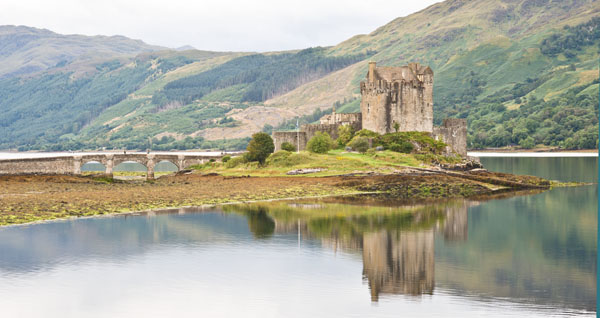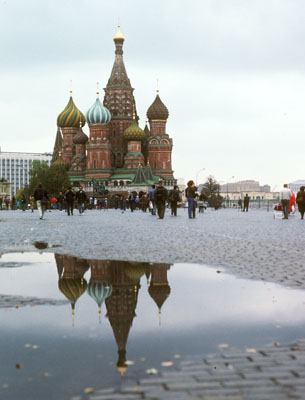The inclusion of a reflection in an architectural image adds not only depth but also a whole new dimension to a composition. The reflected image, typically but not always in the surface of water, provides an inverted and slightly distorted canvas where the building or structure is seen in a different way. The colour and interest in an image is increased considerably, and the result is often more dramatic and balanced.
It is perhaps surprising that many people do not see reflections in everyday life. Their attention is focused entirely upon a particular subject and the eyes are never lowered or deflected to a nearby reflecting surface. This blinkered vision can often be seen in the snaps taken by inexperienced photographers. Beautiful reflections are cut out of pictures by incorrect framing when ample space could have been made available simply by redirecting the camera.
In the image below, Scotland's Eilean Donan Castle is beautifully reflected in the still waters of the surrounding loch.

In a similar shot taken in daylight, the reflection is just as important. Note that the inclusion of the reflection in both images has resulted in the horizon being moved close to the centre of the frame. This is not a composition that a photographer would normally choose in the absence of a reflection because too much foreground would be included and the image might appear uninteresting. The rule of thirds generally produces a more aesthetically pleasing balance. However, in the images shown here, the position of the horizon in the frame is more or less defined by the subject. The rule of thirds has nevertheless still been used to place the castle to the right of centre.

City environments feature reflections of all sorts, particularly as modern glass-and-steel buildings proliferate. Whole buildings can sometimes be seen reflected in the glass surfaces of neighbouring structures or even in wet streets. However, many other sources of reflection can be used to show architecture in a more interesting manner. Any reflective surface can be explored for possibilities including highly-polished surfaces floors, large shop windows and even parts of vehicles. Reflections can also be used to juxtapose old and new architecture, or to create balance or symmetry around a particular line or axis. Even the humble puddle of rain water in the street can be used if the photographer gets down sufficiently low. The picture seen here was taken while the photographer was lying on his stomach in the middle of Moscow's Red Square - much to the amusement of other people!

As with many aspects of photography, it is a matter of training the eye to notice reflections wherever they occur. Not every reflection can or should be included in an architectural image, but all should be noticed by an alert photographer.
Many reflections can be found by habitually looking at the surface of lakes, rivers and ponds. Take the trouble to bend down and see how a lower viewpoint changes the extent of the reflection. Reflections in architecture are more often spotted as a consequence of reflections looking upwards and scanning highly-polished surfaces.
When composing any architectural shot, make sure that available reflections are either incorporated or cut out of an image. Cutting off part of a good reflection serves only to unbalance an image in the same way as a portrait might be unbalanced by cutting off the subjects lower legs and feet.






